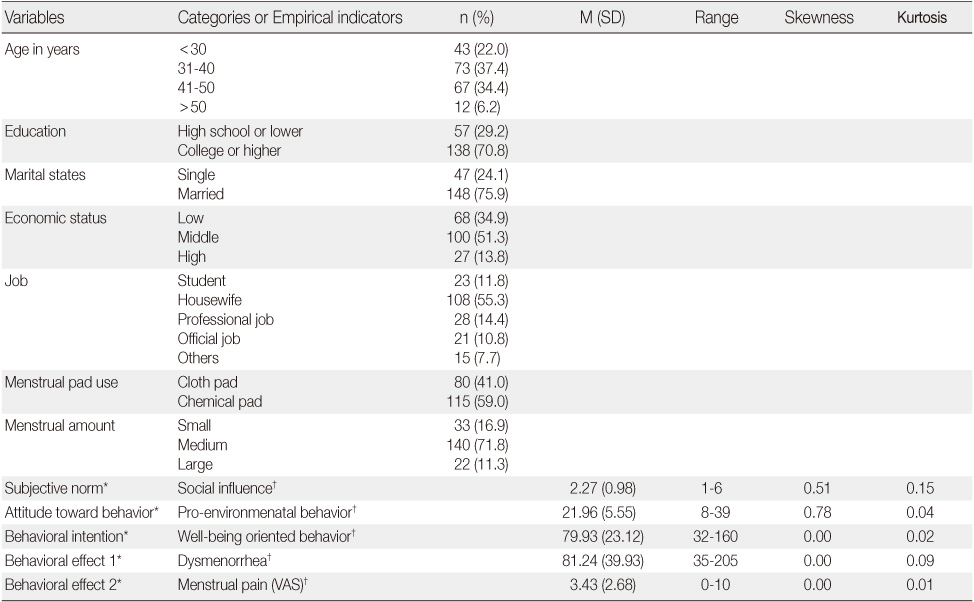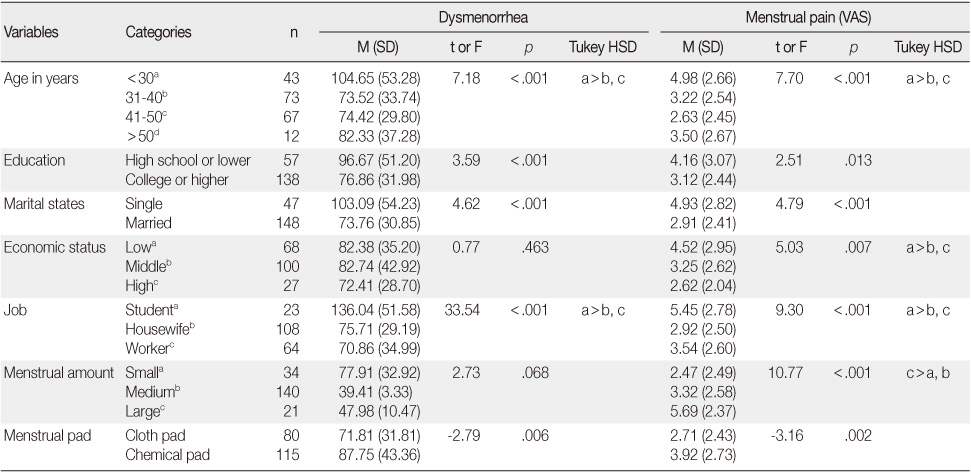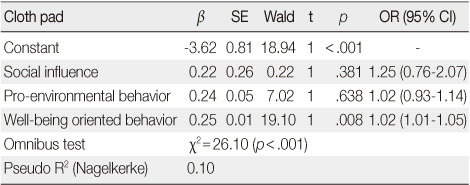Articles
- Page Path
- HOME > J Korean Acad Nurs > Volume 41(2); 2011 > Article
-
Original Article
- Impact of Pro-environmental Behavior on Dysmenorrhea
- Hyun Kyoung Kim
-
Journal of Korean Academy of Nursing 2011;41(2):236-244.
DOI: https://doi.org/10.4040/jkan.2011.41.2.236
Published online: April 30, 2011
Doctoral Student, Ewha Womans University, Seoul, Korea.
- Address reprint requests to: Kim, Hyun Kyoung. Department of Nursing, Ewha Womans University, 11-1 Daehyeon-dong, Seodaemun-gu, Seoul 120-750, Korea. Tel: +82-2-3277-2873, Fax: +82-2-3277-2850, leomommy@hanmail.net
© 2011 Korean Society of Nursing Science
Abstract
-
Purpose
- In this study the impact of pro-environmental behavior, well-being oriented behavior, and use of cloth menstrual pads on dysmenorrhea in Korean female adults was examined according to the theory of reasoned action.
-
Methods
- A cross-sectional study was conducted with 195 Korean female adults. Data were collected from June to August, 2010 using self-report questionnaires. Data were analyzed using t-test, one-way ANOVA, Pearson correlation coefficients, multiple regression, and logit regression with STATA 10.0.
-
Results
- Pro-environmental behavior explained 48% of well-being oriented behavior. Well-being oriented behavior explained 10% of cloth pad use. Use of cloth pad explained 4% of dysmenorrhea and 5% of menstrual pain. The path through well-being oriented behavior had a significant effect from pro-environmental behavior to cloth pad use.
-
Conclusion
- Use of cloth pad was significantly related with well-being oriented behavior, pro-environmental behavior, social influence, dysmenorrhea, and menstrual pain. The results of this study suggest that pro-environmental strategies can help health care providers diminish clients' menstrual symptoms. Nursing intervention can support pro-environmental behavioral strategies.
- 1. Abdul-Razzak KK, Ayoub NM, Abu-Taleb AA, Obeidat BA. Influence of dietary intake of dairy products on dysmenorrhea. The Journal of Obstetrics and Gynaecology Research. 2010;36:377–383.ArticlePubMed
- 2. Ajzen I, Albarracin D, Hornik RC, Fishbein M. Prediction and change of health behavior. 2007;Mahwah, NJ, Lawrence Erlbaum Associates.
- 3. Chiou MH, Wang HH. Predictors of dysmenorrhea and self-care behavior among vocational nursing school female students. The Journal of Nursing Research. 2008;16:17–25.ArticlePubMed
- 4. Choi EH. Comparison of effects lavender abdominal massage and inhalation on dysmenorrhea, pain, anxiety and depression. Journal of Korean Academy of Fundamentals Nursing. 2009;16:420–430.
- 5. Choi SH, Kim HO. Effects of the structured nursing intervention program on dysmenorrhea of middle school girls. Journal of the Korean Society of School Health. 2001;14:145–160.
- 6. Cohen J. Statistical power analysis for the behavioral sciences. 1988;Hillsdale, NJ, Lawrence Erlbaum Associates.
- 7. Durain D. Primary dysmenorrhea: Assessment and management update. Journal of Midwifery & Women's Health. 2004;49:520–528.Article
- 8. Fernandez MF, Santa-Marina L, Ibarluzea JM, Exposito J, Aurrekoetxea JJ, Torne P, et al. Analysis of population characteristics related to the total effective xenoestrogen burden: A biomarker of xenoestrogen exposure in breast cancer. European Journal of Cancer. 2007;43:1290–1299.ArticlePubMed
- 9. Hong KJ, Seo MJ, Yoon SN, Jeon KJ, Im NY, Jung MH, et al. Healthy life-style. Seoul Journal of Nursing. 1992;6:43–59.
- 10. Hong YR. The effects of hand acupuncture therapy on dysmenorrhea. Journal of Korean Academy of Child Health Nursing. 2005;11:109–116.
- 11. Jung HM, Kim YS. Factors affecting dysmenorrhea among adolescents. Korean Journal of Child Health Nursing. 2004;10:196–204.
- 12. Kim BS. Related factors of well-being oriented behavior and typology of well-being consumers. 2006;Daegu, Keimyung University. Unpublished doctoral dissertation.
- 13. Kim EA. Effects of tourmaline gemstone therapy on dysmenorrhea, menstrual pain and prostaglandins of the female university students. 2007;Seoul, Chung-Ang University. Unpublished doctoral dissertation.
- 14. Kim JE. Comprehensive understanding of perimenstrual discomfort: A triangulation of methods and perspectives. 1995;Seoul, Seoul National University. Unpublished doctoral dissertation.
- 15. Kim MJ, Kim BS. The development of the scale of 'Well-being' and the determinants of the well-being oriented behavior. Consumption Culture Study. 2005;8:149–164.
- 16. Kim SY, Lee HY. Effect of the auricular acupressure therapy on dysmenorrhea of puberty girls. Korean Journal of Women Health Nursing. 2010;16:20–28.ArticlePubMed
- 17. Lee HJ, Lee YS, Shin HY, Song EY, Son HJ, Kim IO, et al. Comparative analysis on the effects of abdominal massage using aroma oil and ordinary oil on nurses' dysmenorrhea and painful menstruation. Clinical Nursing Research. 2006;11:121–133.
- 18. Lee IS. A study on dysmenorrhea of women labor workers. Journal of Korea Community Health Nursing Academic Society. 1999;13:115–130.
- 19. Lee IS, Kim JI, Kim HW, Lee HG, Lee SH, Kang NM, et al. Dysmenorrhea and menstrual attitudes in adult women. Korean Journal of Women Health Nursing. 2003;9:105–112.ArticlePDF
- 20. Lee KO, Lee YS. The differing effects of sports training and dietary habits on the menstrual cycle, body composition and bone mineral density, in elite Korean female athletes. Journal of Korean Society of Aerobic Exercise. 2002;6:51–67.
- 21. Lee YS, Kwon OB. Safety of sanitary pad and cosmetics. Quarterly Magazine Environment and Life. 2002;32:202–229.
- 22. Mendola P, Messer LC, Rappazzo K. Science linking environmental contaminant exposures with fertility and reproductive health impacts in the adult female. Fertility and Sterility. 2008;89:e81–e94.ArticlePubMed
- 23. Messing K, Saurel-Cubizolles MJ, Bourgine M, Kaminski M. Factors associated with dysmenorrhea among workers in French poultry slaughterhouses and canneries. Journal of Occupational Medicine. 1993;35:493–500.PubMed
- 24. Moos RH. The development of a menstrual distress questionnaire. Psychosomatic Medicine. 1968;30:853–867.ArticlePubMed
- 25. Morrow C, Naumburg EH. Dysmenorrhea. Primary Care. 2009;36:19–32.ArticlePubMed
- 26. Nasir L, Bope ET. Management of pelvic pain from dysmenorrhea or endometriosis. The Journal of the American Board of Family Practice. 2004;17:S43–S47.ArticlePubMed
- 27. Rier S, Foster WG. Environmental dioxins and endometriosis. Toxicological Sciences. 2002;70:161–170.ArticlePubMed
- 28. Spears LG. A narrative review of medical, chiropractic, and alternative health practices in the treatment of primary dysmenorrhea. Journal of Chiropractic Medicine. 2005;4:76–88.ArticlePubMedPMC
- 29. Vaske JJ, Kobrin KC. Place attachment and environmentally responsible behavior. The Journal of Environmental Education. 2001;32(4):16–21.Article
- 30. Walsh TM, LeBlanc L, McGrath PJ. Menstrual pain intensity, coping, and disability: The role of pain catastrophizing. Pain Medicine. 2003;4:352–361.ArticlePubMed
REFERENCES
Figure & Data
REFERENCES
Citations

- Proposal of Mobile Application Service for a Sustainable Menstrual Experience
Min-Ju Park, Woo-Jeong Chon
Journal of Digital Contents Society.2022; 23(10): 1929. CrossRef - Effects of a dietary modification intervention on menstrual pain and urinary BPA levels: a single group clinical trial
SoMi Park, ChaeWeon Chung
BMC Women's Health.2021;[Epub] CrossRef - Factors Influencing Behavior of Reducing Exposure to Endocrine Disrupting Chemicals in Breastfeeding Mothers
Sun Hyang Kim, Eun-Young Jun
Korean Journal of Women Health Nursing.2018; 24(4): 423. CrossRef - Health behaviors related to endocrine-disrupting chemicals and the associated factors of adolescent Korean girls
SoMi Park, ChaeWeon Chung
Women & Health.2018; 58(8): 915. CrossRef - Relationship between Menstrual Distress and Sleep Disturbance in Middle-school Girls
Se Yeong Park, SoMi Park
Korean Journal of Women Health Nursing.2018; 24(4): 392. CrossRef

Figure 1
Descriptive Statistics of Study Variables (N=195)
*Major variables according to theory of reasoned action; †Empirical indicators of major variables.
Differences in Dysmenorrhea and Menstrual Pain by Study Variables (N=195)
Correlations of Study Variables (N=195)
*p<.05; **p<.001; ***Point biserial correlation was used.
Factors Influencing Dysmenorrhea (N=195)
*Dummy variable.
Factors Influencing Use of Cloth Pad (N=195)
OR=Odds Ratio; CI=Confidence Interval.
*Major variables according to theory of reasoned action; †Empirical indicators of major variables.
*
*Dummy variable.
OR=Odds Ratio; CI=Confidence Interval.
 KSNS
KSNS
 E-SUBMISSION
E-SUBMISSION






 Cite
Cite

